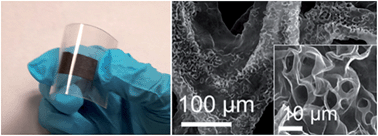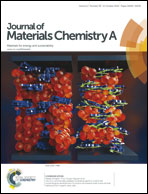Three-dimensional multilevel porous thin graphite nanosuperstructures for Ni(OH)2-based energy storage devices†
Abstract
We report an innovative mechanism for the synthesis of 3-D multilevel porous graphite superstructures using strategically engineered Cu–Ni catalysts. The 3-D thin-graphite nanostructures with two levels of porosity were synthesized by using porous nickel–copper (Ni–Cu) catalysts—engineered from Ni foams via an electrodeposition/etching process. The as-grown graphite is 3-D, multilevel porous, freestanding, and flexible after selective etching of the catalysts. The graphite coated with thin nickel hydroxide nanoplates [Ni(OH)2] was applied as electrodes for alkaline batteries. The electrodes are binder-free and offer a remarkable discharge capacity of ∼480 mA h g−1 at a rate of 1.5 A g−1. Compared to previous reports, they also exhibit excellent cyclability with 97.5% capacitance retention after 4000 cycles. The high performance of the electrodes of porous graphite/Ni(OH)2 could be attributed to the large specific surface area, excellent crystalline quality, controlled Ni(OH)2 nanocrystalline assemblies, and high electric conductivity. Overall, the reported mechanism for the synthesis of 3-D porous graphite is the first of its kind, which may potentially spur a new paradigm for manufacturing 3-D porous graphene/graphite materials for an array of energy storage applications.


 Please wait while we load your content...
Please wait while we load your content...